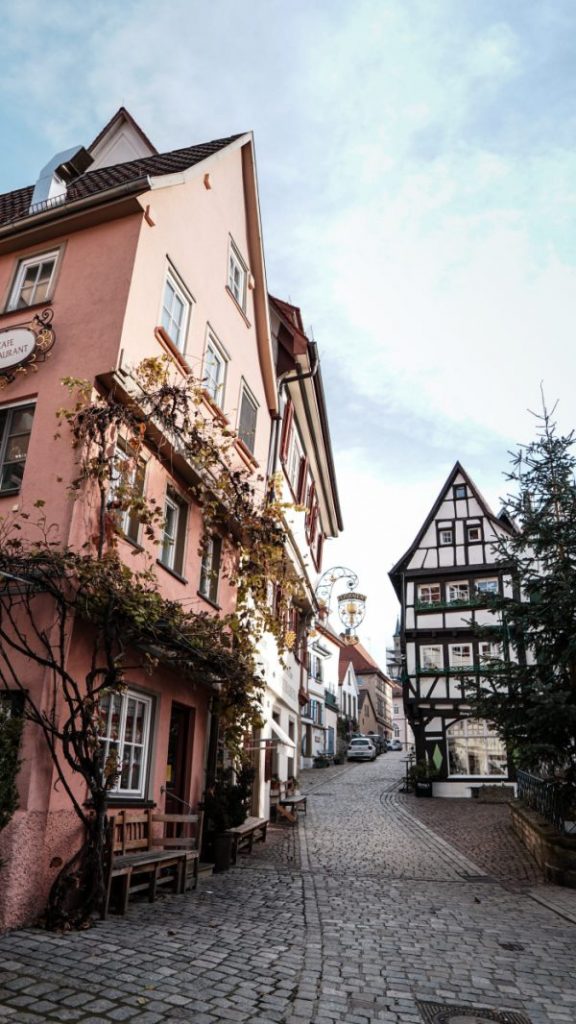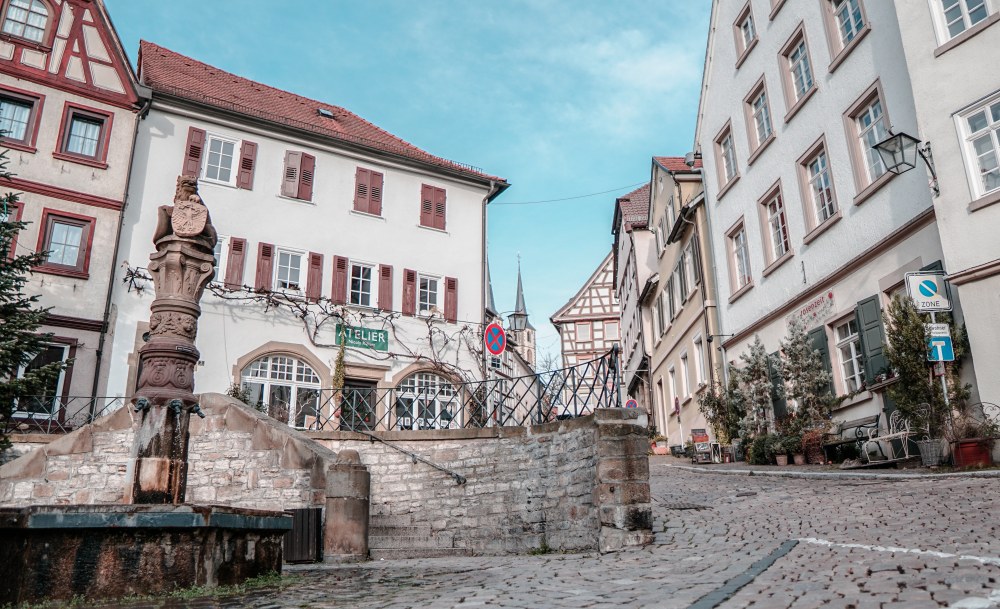Discover Bad Wimpfen from the Hotel Neckarblick
Historic Old Town on the Neckar River
A city from former times
Historical, dreamy and still alive
Bad Wimpfen on the Neckar River attracts guests from all regions. In very few cities the Middle Ages are as visible as here. It impresses with its middle-age old town, its openness and its attractive location.
The lovely valleys of the Neckar, Jagst and Kocher, the Castle Road from Mannheim to Nuremberg, the German “Fachwerkstraße” from Mosbach to Meersburg and the Württemberger Wine Road from Weikersheim to Metzingen are waiting to be discovered and admired. The Neckarsteig from Bad Wimpfen to Heidelberg, a hiking trail that allows you to experience the region in silence and yet still actively.
Discover Bad Wimpfen along the Neckar!
We set off for a small tour of the medieval old town. We reach it comfortably in less than 7, 8 minutes on foot and dive into a jewel – for foreign guests probably the epitome of a German city – narrow, winding alleys, partly steep stairs connecting them, neatly decorated half-timbered houses from which the residents still have a chat with the neighbors. Small contemplative places, the many decorated fountains, the gardens give the feeling of experiencing the Middle Ages. One feels it. The largely preserved and visible city wall shows its power and gives you an idea that something valuable must be protected here. In the middle of it, the sublime Blue Tower, which is today inhabited by the only German tower keeper Blanca Knodel. Climbing the tower is a small experience, on the one hand because of the ascent over 167 steps and on the other hand because of the afterwards unsurpassable view of the Hohenloher Land in the east, in the north the meanders of the Neckar sink into the foothills of the Odenwald, the Kraichgau with its endless hills in the west, the Löwensteiner Berge with its Heilbronner Land in front of it, the Jagst, which finds its way into the Neckar here, close the circle in the south. Directly below us, the red roofs of the old town, laughing in the sun. From up here, you wouldn’t think that there are still alleys and streets between them, everything is so close together. Blanca has a little time and explains us from up here the one and other building.
We leave the tower on the long descent, next to the massive stone house, the biggest Romanesque residential building in Germany, the bower of the biggest Stauferpfalz north of the Alps, the accommodation of the queen.


The view into a small side street makes the magnificent mayor’s Alsatian house with its striking bay window look reverent. The Palatine Chapel, which is connected to the Stone House via the arcade passage along the town wall. The splendour of the arcades makes one guess in which honour and pride the imperial family resided here. The Red Tower is not much less massive than the Blue Tower, but today without the beautiful roofing, which was destroyed by multiple fires. In front of it is a small open square, which opens into the round a view of the Nuremberg Tower and large parts of the city wall. From here also a wonderful view of the valley town of Wimpfen. The origins of the city go back to the Celts and Romans, who secured the Limes with a fort here. The defensive wall of the Roman fort has remained the decisive factor for the still largely preserved medieval walls of the valley town and the town plan. The Knights’ Abbey Church of St. Peter, which can be discovered in a special way during a guided tour, is located in the centre of the Roman fort. The Neckar river, a passenger ship goes downhill towards Gundelsheim, which can be easily seen in the background through its castle Horneck. Two Neckar loops further on you can still see Hornberg Castle, the retirement home of Götz von Berlichingen. But more about this story elsewhere.
Right next to it is an inconspicuous building, today it is the town archive of Bad Wimpfen. In 1837 the Hessian Grand Duke Ludwig II had the prison built, in 1945 the American occupying forces disbanded it. Seven years later Bad Wimpfen’s status as an exclave of Hesse, whose southernmost border strip lies 40 kilometres north of here, also ended. In 1952 the town fell to Württemberg by referendum.
We continue our walk and reach the “Schwibbogenentor”. A steep staircase leads back to the Palas. The former magic that started from this staircase has been lost due to the renovation of the steps and the banister. Straight ahead the view falls into a flower-decorated alley, the morning sun shines on this corner in an enchanted light, on the right side beautiful small gardens, which are protected by massive walls and the entrance is decorated with a heavy wrought-iron gate. A woman waters with love and devotion the perennials which are now in full bloom.

Through the “Schwibbogentor” we reach the main street, even more magnificent half-timbered houses like in the castle quarter are waiting for us and they let us pause with their special half-timbering. What work, what effort are the thoughts. The architecture fascinates us. Small shops, restaurants and cafes line this street that runs right through the old town centre. Almost every restaurant has a small terrace and every time we have the opportunity to stop for a bite to eat, we find it difficult to continue our tour. We would like to settle down. The big city gate opens in the direction of Talstadt, in the opposite direction we reach a small plaza, the beautiful fountain in the middle is decorated with countless flowers, an alley at the right leads steeply up to the market place.
On the left in front of us the old hospital of Wimpfen. The Reichsstädtische Museum is located in this hospital, the cultural office is on the ground floor, we enter and are welcomed friendly. We are astonished to what extent a cultural programme is offered here, which is remarkable for a small town like Bad Wimpfen, we think.

The path continues slightly uphill along the main road, from a small window ice cream in crispy wafer cones is offered. We cannot resist. We stop at the Eagle Fountain and admire the beautiful half-timbered buildings that line the small square.
The Salzgasse leads us back to the market place. Also this place is again decorated with a fountain in the middle, the city hall, the imposing building captivates with its form. Here, the Hessian past is evident, as the Hessian lion and a writing: “Hessen 1803-1952” shine on the classicistic building from 1839. But other eras are also documented on the columns between the arched windows.
A short flight of stairs leads us to the protestant town church, towards the main portal we pass the crucifixion group of the Mainz master baker’s oven. Opposite the Wormser Hof and the Zehntscheune, it was the seat of the representative of the Bishop of Mainz, who had to collect in Wimpfen the interest, tithes and various other amounts that had remained from his former reign. Nowadays the whole procedure is handled by the tax office in Heilbronn.
After 2 hours the rough cobblestones have left their marks and we feel our feet. A lot is still unvisited and we have made a second round through the dreamlike little town. The many small alleyways, which also let expect some history; was promised to us. But for today we got so many impressions and on the way home we are already looking forward to the next round tour. We also planned a night watchman guidance, the city should have a special charm in the night lighting.
We are sure that Bad Wimpfen is an insider tip for a relaxing holiday in a romantic ambience, especially as we hardly knew the small town before.

We are also just imagining, when in this ambience the announced events like the “Reichsstadtfest”, the “Zunftmarkt”, “Montmartre”, the event “Brunnen und Gärten” or the “Kunstnacht” will take place, in which glamour the small town will probably appear. The “Old German Christmas Market” on the first three Advent weekends must be the highest of these.


